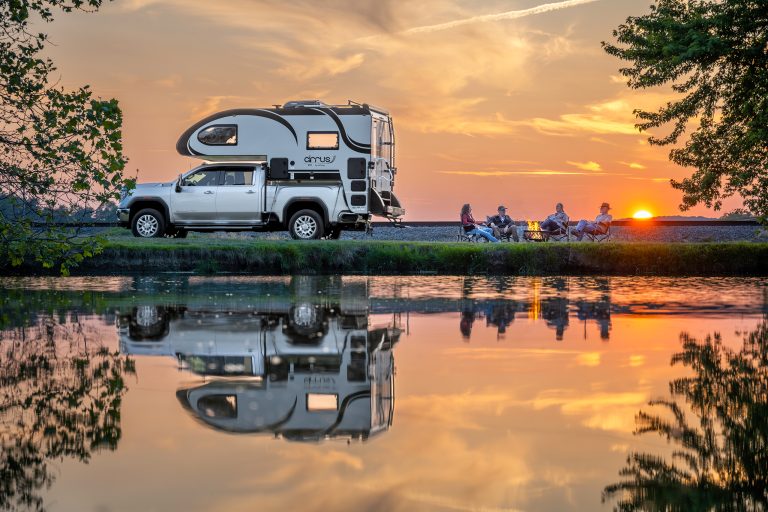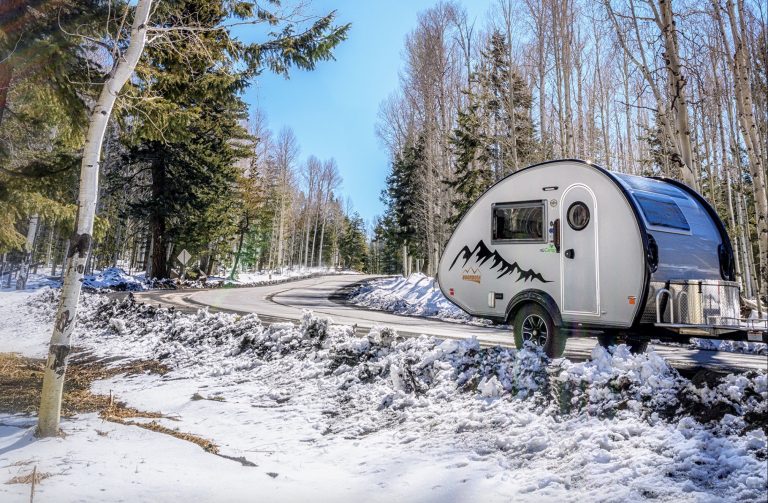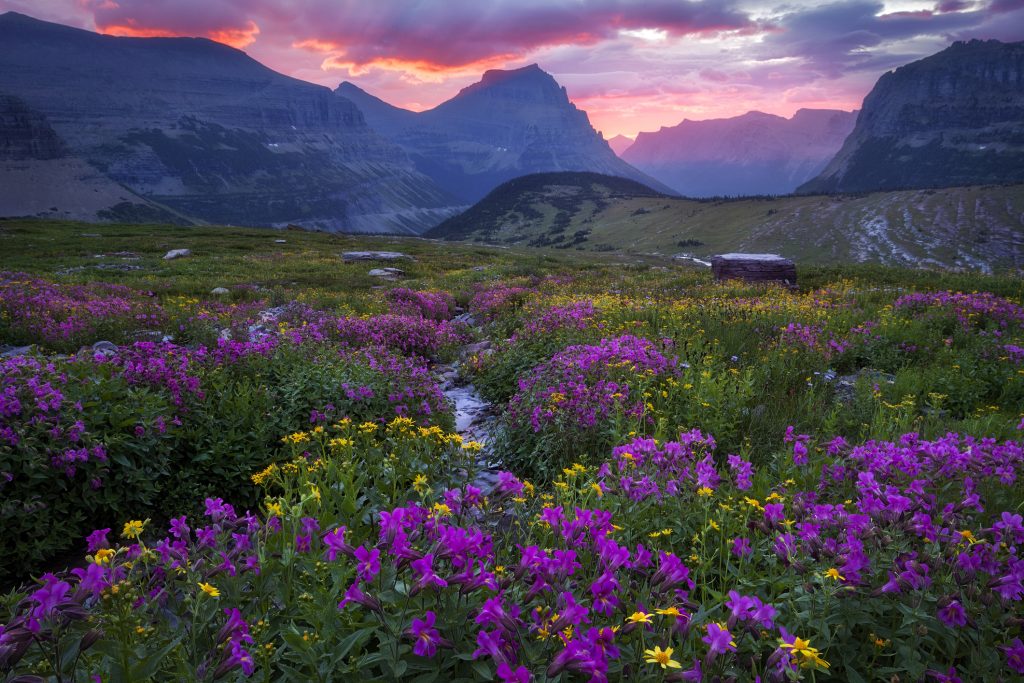You can enjoy the beauty and splendor of America’s national parks all year round, but there’s something special about springtime. Nature awakens, and flowers bloom after a long and cold winter sleep. The already breathtaking landscapes are painted with vibrant colors as wildflowers bud in pops of blue, gold, purple, and white.
If you’re ready to enjoy seasonal blooms, bookmark these top National Parks to enjoy a diverse array of floral displays. You can also use the Wildflower Search page to find where and when to go and what wildflowers you’ll see when you get there.
Before you head out to view these delicate blooms, heed this advice from the Lonely Planet: stay on designated trails and resist the urge to pick flowers or remove any plants. As explained on the Mt Rainier National Park website, off-trail footfalls can negatively affect the condition of the plants and wear away soil, potentially damaging the roots. And if you pick a flower, you are also hindering its ability to make and spread seeds, which means less blooms will be there for future generations to enjoy.
Top National Parks for Wildflowers
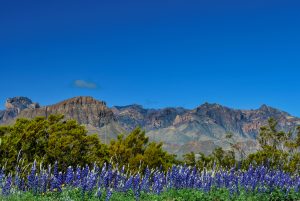
At Big Bend National Park, spring can arrive as early as February, with mild temperatures sometimes lasting into April. Some of the spring bloomers include yuccas, ocotillo, and bicolor mustard. The color palette is as diverse as the types of blooms, ranging from white and green (blackfoot daisies, Antelope horns milkweed, and Texas madrone), orange to yellow (desert marigolds, yellow bells, and agarito), blue to purple (Big Bend bluebonnets, snapdragon vine, and bluecurls), and red to pink to brown (ocotillo, strawberry cactus, and fragrant mimosa).
Great Smoky Mountains National Park, NC, TN
Sometimes called “Wildflower National Park,” Great Smoky Mountains National Park is a world-renowned preserve of wildflower diversity, with more than 1,500 kinds of flowering plants found there. (See the Plant List for Great Smoky Mountains National Park for a detailed breakdown.)
Although blooming flowers can be found year-round, the spring ephemerals kick off the show, appearing in late winter and then vanishing after a two-month season, usually by May or June. Among those are trillium (of which the park has ten different species), lady slipper orchids, showy orchids, crested dwarf iris, fire pink, columbine, phacelia, jack-in-the-pulpit, little brown jugs, bleeding heart, and violets. The Park’s Wildflower Walks provide optimum viewing opportunities while participating in the week-long Spring Wildflower Pilgrimage provides an entertaining and educational way to explore the region’s rich natural and cultural resources.
North Cascades National Park, WA
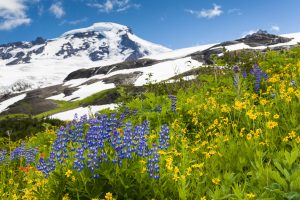
North Cascades National Park is a veritable wildflower wonderland, with blooming plants found everywhere you look: on wet hillside seeps, shady forest floors, dry east-side slopes, and exposed alpine ridges. The range of flowering times is directly related to the great differences in elevation, exposure, and precipitation. Plants in the low-elevation forests will bloom by late February and early March, while those in the alpine zone will flower as late as August and into early September.
Some of the plants include lupine, heather, evergreen violet, paintbrush, alpine cinquefoil, red columbine, phlox, tiger lily, fireweed, alpine aster, and beargrass. The majority of flowers are pollinated by insects or the wind, but some, such as salmonberry, Indian plum, and red-flowering currant, owe their pollination to the hummingbirds returning to the area to breed.
Yosemite National Park is another prime location for wildflower enthusiasts, with its 11,000-foot range in elevation offering a gamut of growing conditions. It could be considered a species crossroads, with plants traveling from the Pacific coast, Great Basin, southern deserts, and northern mountains to settle in the central Sierra Nevada area.
As a result, Yosemite has 1,450 species, with 25% of California’s native plants represented within its borders. These include the Kellogg’s monkeyflower (found at the lowest park elevations), Sukdorf’s monkeyflower (in the high country), and Yosemite woolly sunflower, only found in the park’s region.
In the lower elevations, March brings tufted poppies, spider lupines, fiddlenecks, popcorn flowers, owl’s clover and redbuds, followed in May by shooting stars, showy milkweed, cow parsnip, western azalea, pine violets, evening primrose, seep-spring monkeyflower, Applegate’s paintbrush, baby blue eyes, bird’s eyes, larkspur, and dogwood.
At higher elevations, the flower show begins with the snow plant, followed by mountain pride, spreading phlox, sulfur buckwheat, mouse-tail, mountain pennyroyal, sandwort, yellow and red monkeyflowers, Sierra forget-me-nots, and pretty face. If you’re near wet meadows or stream banks, you may spot corn lily, monkshood, shooting stars, arrow leaf groundsel, leopard lily, rein orchids, marsh marigold, and great red paintbrush, while in the forest, you’ll find groundsel, lupines, red columbine, wallflower, coralroot orchid, dogbane, mariposa lily, and wild strawberry.

Glacier National Park is the meeting ground of four major floristic provinces. Its ecosystem supports a diverse array of plant species and plant communities, including nearly a thousand species of wildflowers. Some, like clematis, pinesaps, and Indian pipes, are located in the lowlands, while others, such as Northern eyebright, three-flowered rush, and false asphodel, are in the alpine zone. Nearly all alpine plants are perennials since, in these severe conditions, there isn’t enough time or warmth for an annual’s life cycle to complete.
While not technically a spring wildflower destination since the majority come into their own from late June to mid-July, Glacier still deserves a spot on the list for those who want to end their spring wildflower hunt just when summer is coming into its own.
Yellowstone National State Park, ID, MT, WY
When searching for wildflowers in Yellowstone, you might want to consider their “personalities.” Lupines and arnica like to hide under the forest canopy, but for show-offs like spring beauties, glacier lilies, and steer’s head, the open meadows and sagebrush steppe are ideal stages for their performance. Visit this page for a breakdown of the blooming period by color, location, and plant.
Besides thrilling visitors with their range of colors and textures, wildflowers also serve a valuable role. Grizzly bears regard the bulbs of spring beauty and glacier lily as a diet staple in spring, while wild strawberries are the food of choice for ground squirrels and chipmunks. Birds and insects enjoy the seeds, while bees and other insects collect nectar and pollen.
The 200,000 acres of Shenandoah National Park have all that a nature-lover could ask for: cascading waterfalls, spectacular vistas, and quiet wooded hollows. And let’s not forget the fields of wildflowers that decorate the land from early spring until fall. Wildflowers comprise 862 species, or greater than half of the 1406 vascular plant species found in Shenandoah, with 20% of these species are in the aster family.
The early bloomers include hepatica and bloodroot, followed by purple and yellow violets, trillium, pink lady’s slippers, and wild geraniums. Find these at the lower elevations along streams such as South River, Hughes River, Rose River, and Mill Prong. If you want more information about wildflowers in Shenandoah, view the wildflower calendar or the complete species list of wildflowers.
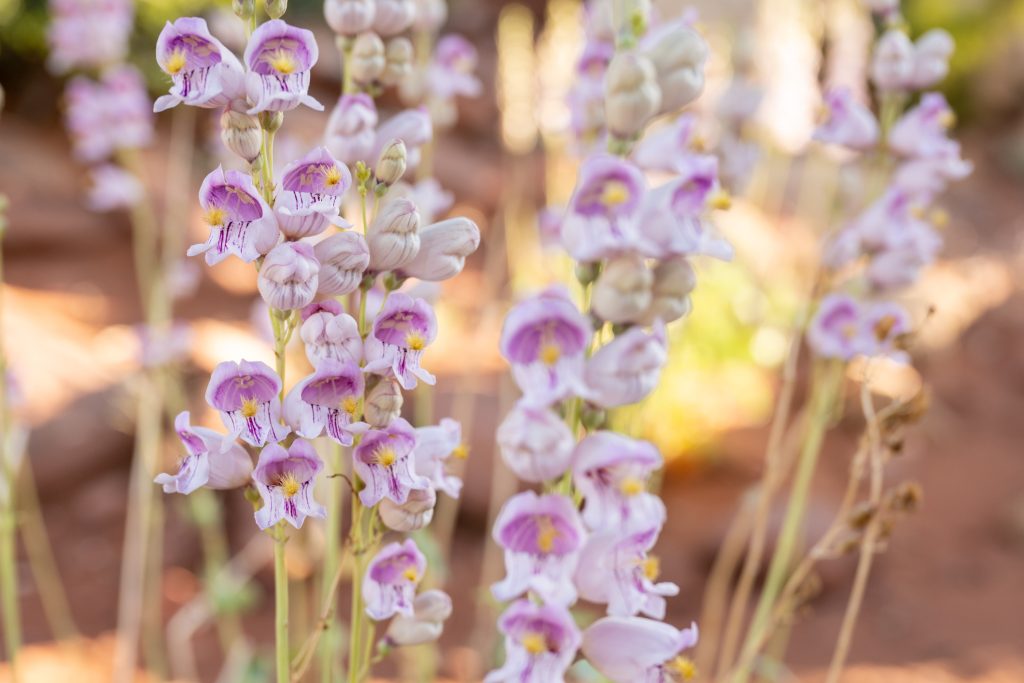
With hundreds of flowering plant species, Zion National Park deserves to be on the list of destinations. And to make it easier, you can download the free Zion Park Wildflowers app (iOS) that will enable you to conduct searches using a range of plant characteristics, so you can keep track of what you see. So what do spring temperatures and rainfall bring? The brilliant colors of desert marigold and slickrock paintbrush appear from early- to mid-April, as well as Golden columbine, larkspur, and tufted evening-primrose. Download a complete list here.
You might think Joshua Tree National Park is all desert and scrubland, but there is a wide diversity of plants, from cacti and palm trees to lichen, bushes, and, of course, Joshua trees, the park’s namesake species. As for wildflowers, you can thank winter showers for the display of blooms. From January to mid-April, lower elevations provide a home for Arizona Lupine, Desert Gold, Desert Canterbury Bells, and poppies, while at the 3,000-to-5,000-foot elevations, early March to early May brings Desert Dandelion, Desert Globemallow, Brittlebush, Indian Paintbrush, and Pincushions.
Later arrivals appear on mountain slopes and pinyon pine/juniper woodlands at 5,000 feet and higher elevations, including Desert Mariposa, Blackbush, Beavertail Cactus, and Desert Fiddleneck. Whenever you visit, the Park asks that you avoid stepping on vegetation and flowers, especially since they tend to be extremely low-growing. For the same reason, stay on trails and resist the urge to pick flowers as that can reduce the potential for future growth.
Although the peak blooming season at Pinnacles is from March through May, when more than three-quarters of the plants are in bloom, rainfall and temperatures can influence the flowering season. In January and February, manzanita, milkmaids, shooting stars, and Indian warriors appear, followed by California poppies, fiddleneck, peppergrass, filaree, fiesta flower, monkeyflower, and baby blue-eyes as well as flowering bushes such as bush poppies and buck brush.
Come April, Johnny-jump-ups, virgin’s bower, gilia, suncups, chia, black sage, pitcher sage, larkspur, and bush lupine come out of hiding, but by May, the focus is on those species that can take the hotter and drier weather: chamise, buckwheat, clarkias, orchids, penstemons, and roses. It’s also worth noting that Pinnacles is home to four rare or threatened plants: Graptophyllum excelsum (scarlet fuchsia), Commersonia reticulata, Dubouzetia saxatilis, and Sannantha papillosa, highlighting the importance of protecting plants from over-eager visitors.
Death Valley National Park, CA, NV
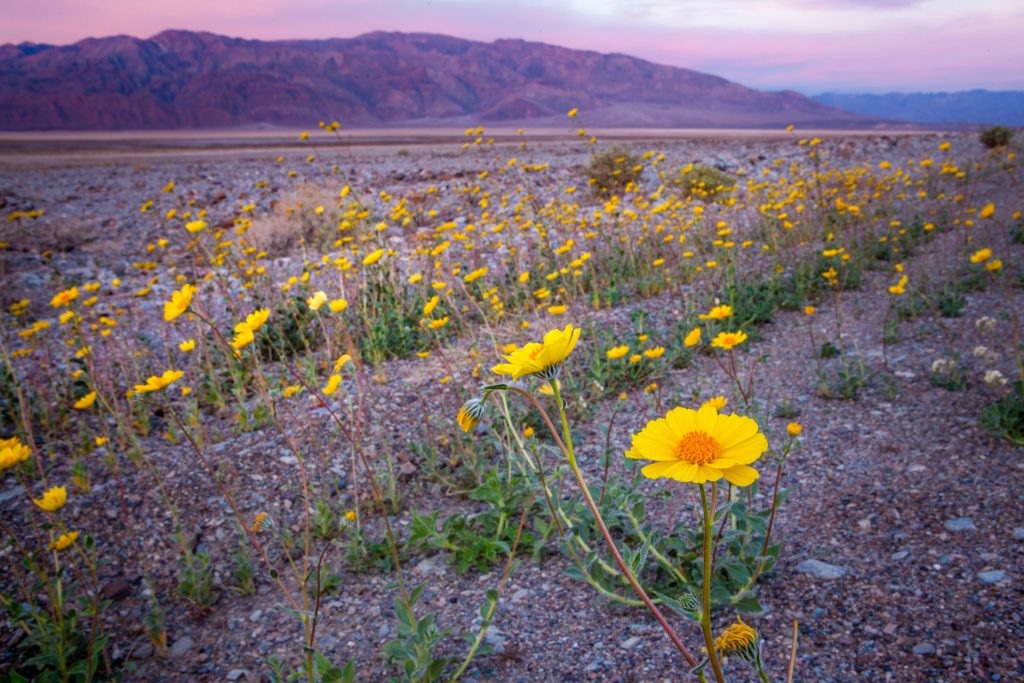
With a name like Death Valley, it’s understandable that you’d think there is nothing alive there. But you’d be wrong. While it is the hottest, driest, and lowest national park, it is also home to life in terms of animals and plants. Regarding the latter, Death Valley has a great diversity of plants, in part due to its variety of different environments throughout its three million acres.
Once a decade, Death Valley has a spectacular carpet of wildflowers known as a superbloom, the result of fall and winter rains and widespread germination. But even without the arrival of a superbloom experience, you can still enjoy the wildflowers that bloom from mid-February to mid-July. From mid-February to mid-April, lower elevations showcase Desert Gold, Notch-leaf Phacelia, Caltha-leaf Phacelia, Golden Evening Primrose, Gravel Ghost, Bigelow Monkeyflower, and Desert Five-spot.
Next up on higher elevations are Desert Dandelion, Brittlebush, Princesplume, Desert Paintbrush, and Desert Globemallow, among others. The next few months will bring blooms at higher elevations (5,000 to 11,000 feet). Death Valley is also home to annuals, called ephemerals, due to their short lifespan. These annuals remain dormant as seeds, waiting for rains that enable them to sprout, grow and bloom before going back to seed state.
Recent Articles

